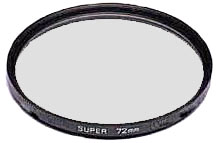
Rays of light reflected from any surface may become polarized. This makes them different and hence separable from unpolarized rays. Polarizing filters, such as the Hoya Circular PL, have the potential to block polarized rays reflected from non-metallic surfaces such as water and glass without affecting the colour balance in an image. Most polarizing filters require an increase in exposure of two or three stops.
There are basically two types of polarizer - linear and circular. Both achieve essential the same result but only circular polarizers can be used with autofocus cameras. This is because some autofocus systems use a semi-silvered mirror or prism to split the light entering the lens as part of the process of automatically calculating exposure and achieving correct focus. Note that the description "circular" has nothing to do with the physical shape of the filter!
Polarizing filters are supplied in rotating mounts because they must be correctly aligned with the polarization of particular rays. Look through the viewfinder of an SLR and rotate the filter until unwanted reflections are eliminated or minimized.
Since polarized light also decreases colour saturation and causes haze, under most circumstances these filters produce clearer colours and good colour contrast. Blue skies and white clouds become more dramatic, and colour saturation generally increases. However, the effect is dependent upon the direction of the light falling on the subject. The most dramatic effects are achieved when side-lighting prevails. Skies may then be lightened or darkened without changing other tones in the photograph. Subjects lit from the front may be virtually unaffected.
Care must be taken not to over-polarize clear blue skies which can be rendered almost black in some circumstances. Look through the viewfinder and rotate the filter only far enough to achieve the desired effect. Expanses of water can also be lightened or darkened by rotating the filter. Polarizing filters also block ultra-violet rays and therefore help to penetrate haze. When combined with a yellow filter they strongly darken skies, leaving other colours relatively unchanged.
Filter factors are generally around 3 x.